Wallaby.js for Visual Studio Code
Wallaby.js is a continuous test runner for JavaScript. It solves the fundamental issue of being able to provide an instant feedback from your tests as you write your code, no matter how large your codebase is. Wallaby.js uses smart dependency analysis to only execute tests affected by your code changes and leverages parallel test execution.
It also displays test execution results, including code coverage, right in your code editor. No context switching, no need to switch to browser - it’s game changing. The tool pays for itself very quickly and is bringing you to a whole new productivity level.
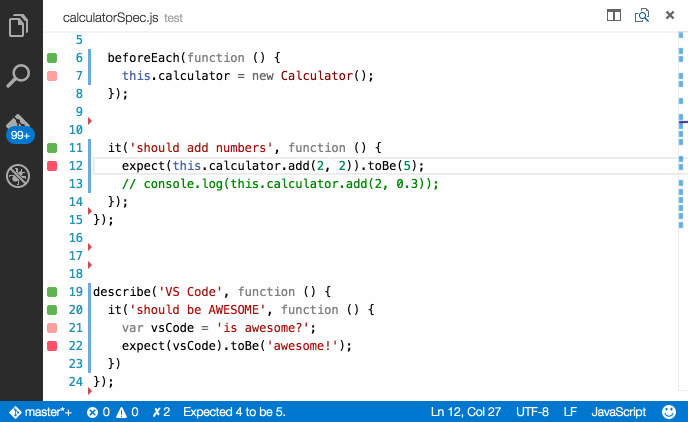
When wallaby.js was released early this year, it was supporting only IntelliJ platform IDEs, such as WebStorm and IntelliJ IDEA, a few months ago we have added Visual Studio and Atom editor support.
Now it’s time to bring the awesomeness of wallaby to Visual Studio Code editor. The streamlined and powerful editor plus the power of wallaby.js is a great combo to deal with JavaScript and TypeScript projects of any size fast and easy.
Setting up
Wallaby.js for Visual Studio Code consists of two separately versioned parts: wallaby.js Extension and wallaby.js Core.
To get started, you need to install Wallaby.js Extension from your editor (using Extensions: Install Extension command).

After the extension is installed, wallaby.js Core will be automatically downloaded and installed. Please note, that the very first time wallaby.js needs to download and install its dependencies, so it may take a minute or two. Further updates are much faster. The notification is displayed when the installation is finished.

Sample code
For this tutorial I will use this sample calculator repository. You can clone it to try locally:
git clone https://github.com/wallabyjs/calculator-sample.git
Once you have the source code locally, open the project folder in Visual Studio Code.
There you will find a simple calculator project there with wallaby.js configuration file. Wallaby configuration file is a simple JSON or JavaScript file in your project root folder with just a couple of mandatory settings. The configuration file includes a list of files and tests of your application as well as some settings for various technologies that you may be using to build your project, such as Webpack or Browserify configuration Babel/CoffeeScript/TypeScript compiler options, etc.
Wallaby supports lots of technologies and scenarios, we have collection of sample projects with configuration files for different tools, frameworks and languages, such as Webpack, Browserify, ES6 and ES7 via Babel, TypeScript and CoffeeScript, React and Angular, node.js and io.js, etc.

First steps
Selecting wallaby.js config file
Wallaby.js for Visual Studio Code needs to know what configuration file to use to run your tests. If you only have one file named wallaby.js/wallaby.conf.js or wallaby.json in your project root, wallaby will automatically select it.
However, if you have multiple configuration files, use different naming convention or have the config file not in the root folder, you may select the config file using Wallaby.js: Select Configuration File command from the editor Command Palette.

Wallaby.js Command Palette
As you probably know, you may press Ctrl/Cmd + Shift + P in Visual Studio Code to get the editor Command Palette in case if you’ve forgotten some shortcuts or just like invoking commands this way. There you may search for wallaby and use the found commands.
Also, for your convenience wallaby.js adds its own Command Palette to the editor that you may display by pressing Ctrl/Cmd + Shift + =. It’s a fast and easy way to quickly use various wallaby features.
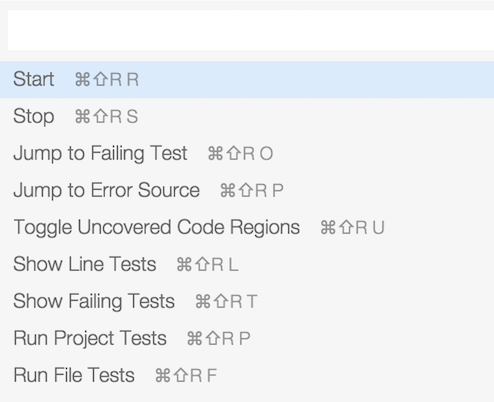
Now let’s have some fun.
Let’s try starting wallaby.js: to do that you need to invoke wallaby Start command. You may do it by using the Ctrl/Cmd + Shift + R, R shortcut, or using wallaby Command Palette.
To stop wallaby.js, you may use the Stop command.
Wallaby.js in action

Once you have started wallaby.js, at the bottom left corner of the editor you’ll see wallaby status indicator. It’s job is pretty simple: when it displays a spinner - your tests are running, when it shows a cross - you have some failing tests, when it shows a tick - all of your tests are passing. It also shows the number of failing or passing tests, and you may also use the indicator to show ‘Wallaby.js Tests’ Output Channel by clicking it.
Now, let’s open the sample calculator project spec (test/calculatorSpec.js).
When wallaby.js is running, you can see the code coverage in opened source files (specified in wallaby configuration file). As you can see, there are various colored squares displayed for each line of your source code.
Try jumping to any of the passing tests and break it, for example try changing the 2 plus 2 expectation result to 5 in the should add numbers test, or try breaking the code covered by the test. Right after the change wallaby.js automatically runs your tests and displays the result in status bar.

The code coverage and messages are automatically updated, just as you type.
Also, try editing some console.log arguments or just console.log any object you like.
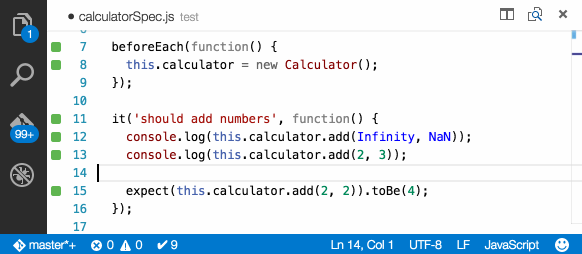
This is a great way to quickly inspect any objects without having to leave your editor, without switching to any other console. Think how cool it is - your code editor is your console with all the required context.
Coverage indicators
Let’s have a look at the editor gutter where you may see some indicators. Here is what these coverage indicators mean:
- Gray square means that the source line is not covered by any of your tests.
- Green square means that the source line is covered by at least one of your tests.
- Yellow square means that the source line is only partially covered by some of your tests.
- Red square means that the source line is the source of an error or failed expectation, or is in the stack of an error.
- Pink square means that the source line is on the execution path of a failing test.
Failing tests
‘Wallaby.js Tests’ Output Channel displays all tests that are currently failing along with the error stacks and registered console.log calls. Some bits of the displayed information are hyperlinks so you can navigate to different places, for example to the exact error line, or a line where something is logged to console. To quickly focus the panel you may use the Show Failing Tests wallaby command (Ctrl/Cmd + Shift + R, T).
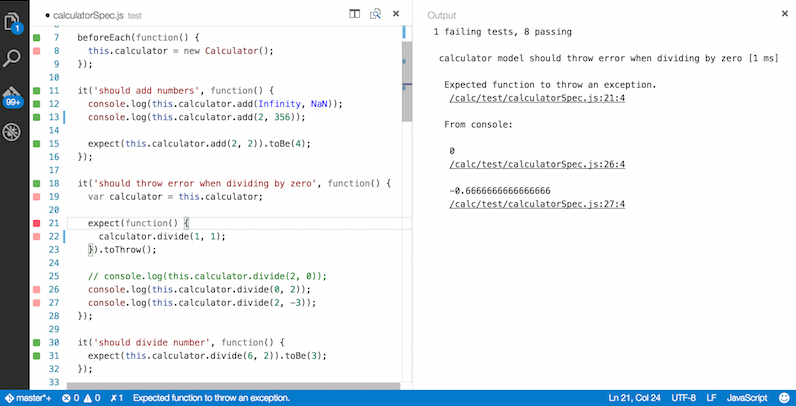
Commands
To help you writing/navigating your code and tests more efficiently, wallaby.js provides a few commands. You may see the full list in the wallaby.js Command Palette (Ctrl/Cmd + Shift + =).
These commands include:
- Show line tests: displays the line related test data. The command allows you to quickly view all tests (both failing and passing) that cover the current line of code, navigate to test and code errors, view console messages related to some specific test or some source code line.
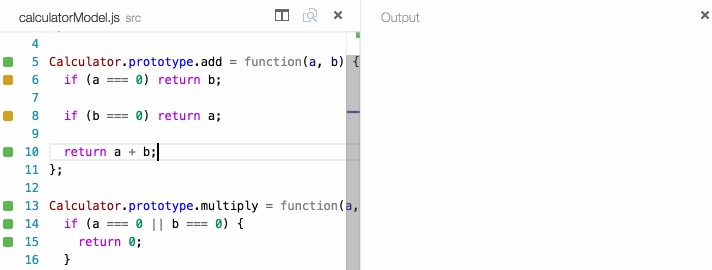
- Jump to failing test: allows to quickly navigate to the failing test from any ‘pink’ context (the failing test execution path).
- Jump to error source: allows to quickly navigate to the source of the test error from any ‘pink’ context (failing test execution path).
- Toggle uncovered regions: displays/hides uncovered regions for an opened file. The command is very useful for ‘yellow’ lines to display what is exactly not covered in the line. Highlighted markers will automatically disappear when you start editing your code.
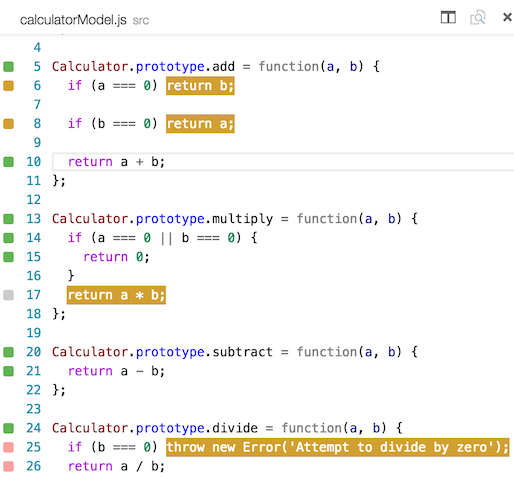
- Run line tests: the command is pretty simple, it just runs a single test (if invoked from within the test) or all related tests (if invoked within some source code covered by the tests).
- Run file tests: the command runs all tests within the test file it is invoked in, or all tests in all the test files that cover the source file that the command is invoked within.
- Run project tests: the command runs all project tests.
Troubleshooting
If you encounter any issues with configuring or using wallaby.js and not sure why it happens, check out our troubleshooting docs section or search our public repository issues to see if someone else have been experiencing something similar.
Another useful technique is to run wallaby.js with the debug flag set to true. In this case wallaby outputs a lot of additional information about the test execution progress which may help you to understand what’s going on if something goes wrong. The output can be viewed in the Wallaby.js Console Output Channel.

More information
- Follow us on twitter and subscribe to our newsletter to stay updated.
- Browse our full documentation, ask questions or create issues.
- Check out wallaby.js planned pricing for Visual Studio Code to get an idea how much it’ll cost after the beta period ends.
- Consider getting yourself a copy of ‘Freedom’ license today to help the project and be able to use wallaby.js in any editor that we support today and will support in future.